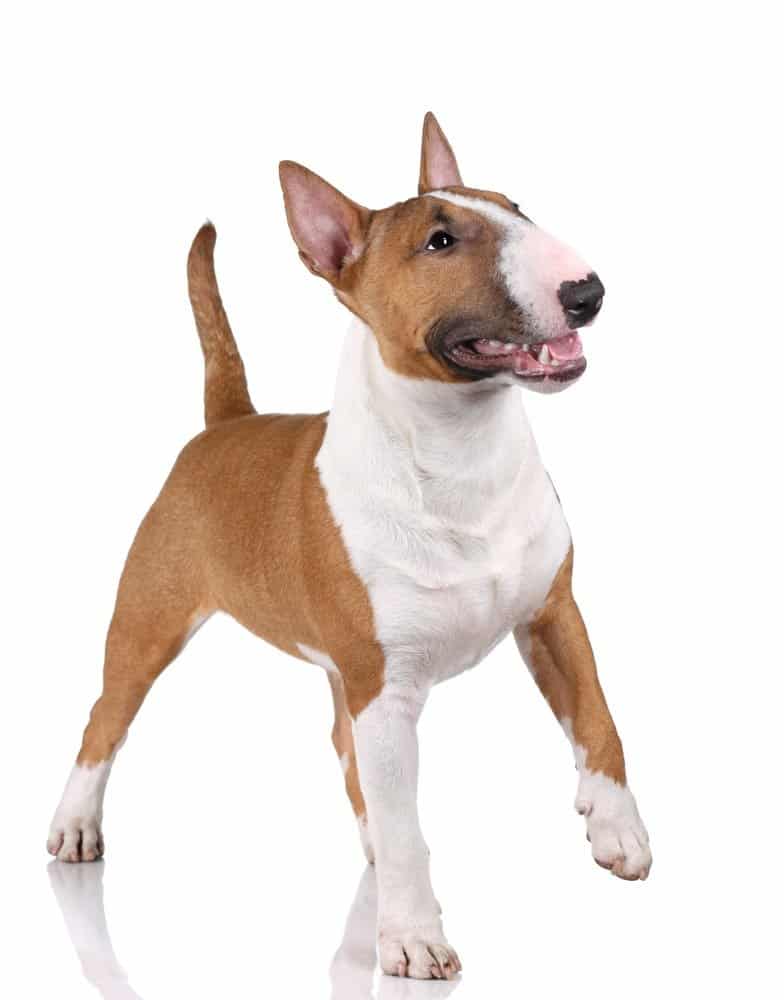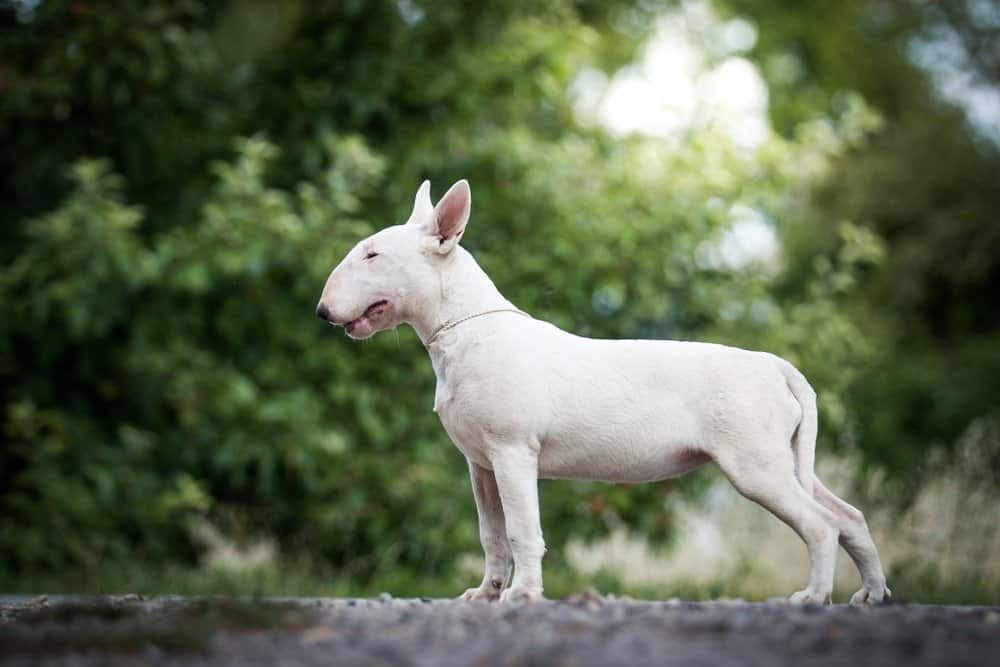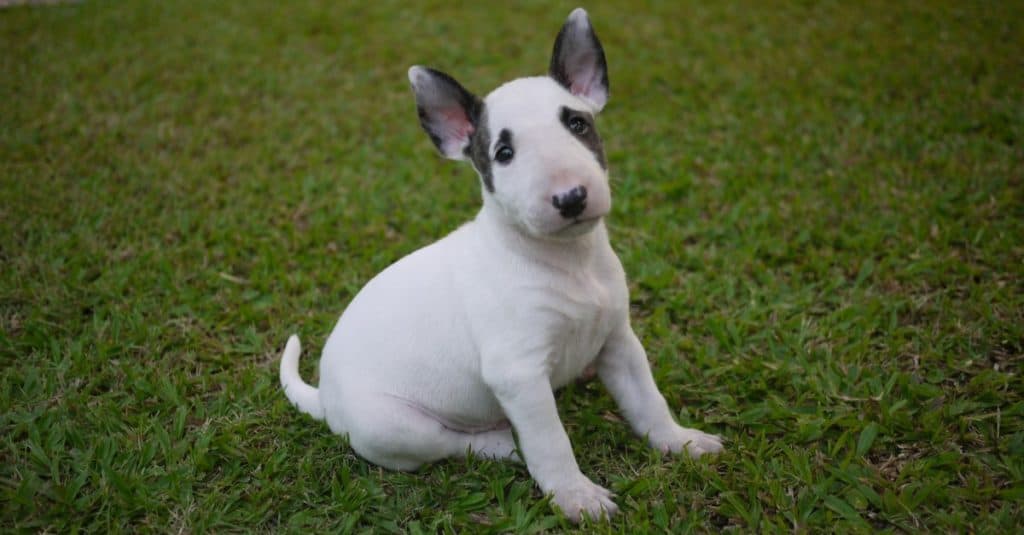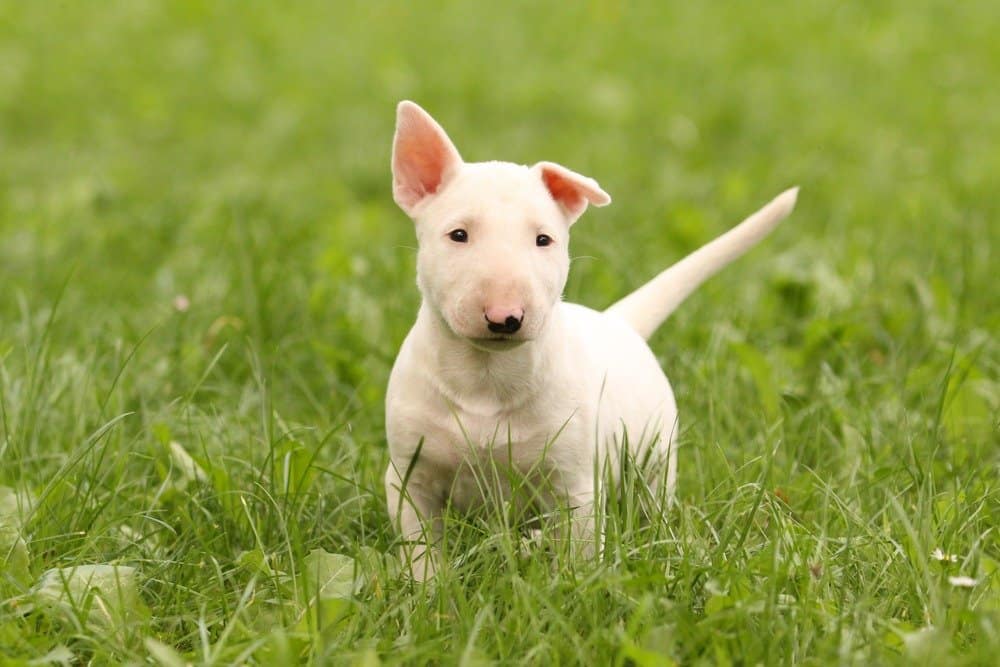Bull Terrier
Canis Lupus
Needs to be kept active!
Advertisement
Bull Terrier Scientific Classification
- Kingdom
- Animalia
- Phylum
- Chordata
- Class
- Mammalia
- Order
- Carnivora
- Family
- Canidae
- Genus
- Canis
- Scientific Name
- Canis Lupus
Read our Complete Guide to Classification of Animals.
Bull Terrier Conservation Status
Bull Terrier Facts
- Temperament
- Friendly and alert but stubborn
- Training
- Should be trained from an early age due to their independent nature
- Diet
- Omnivore
- Average Litter Size
- 7
Bull Terrier as a Pet:
- General Health
- Energy Level
- Shedability
- Trainability
- Intelligence
- Tendency to Chew
- Size
- Family and kid friendliness
- Yappiness / Barking
- Low
- Separation Anxiety
- Moderate
- Preferred Temperature
- Warm climate
- Exercise Needs
- High
- Friendly With Other Dogs
- Moderate
- Pure bred cost to own
- $500 and $3,500
- Dog group
- Terrier
- Male weight
- 55-65 lbs
- Female weight
- 45-55 lbs
This post may contain affiliate links to our partners like Chewy, Amazon, and others. Purchasing through these helps us further the A-Z Animals mission to educate about the world's species.
View all of the Bull Terrier images!
Bull terriers are high-energy, strong dogs known for their friendliness and persistence.
Bull terriers have an independent streak which can make them challenging to train. This dog has a sad history that dates back to 13th century Britain. A group of dogs would participate in a sporting or blood sports competition known as bullbaiting. The dogs were released to attack a bull while observers bet on the winning dog. Later in the early 1800s, this dog was put into fierce dogfighting competitions held in a pit or cellar below a tavern. These dogs are sometimes referred to as pit bulls.
See all of our expert product reviews.
Despite its violent history in these sporting activities, the bull terrier is a friendly dog with a playful nature. It’s loyal and serves as an excellent companion and guard dog.
Another type of bull terrier, called the White Cavalier, was a favorite with royalty in the 1860s. It’s notable for its all-white coat of fur.

3 Pros and Cons of Owning a Bull Terrier
| Pros! | Cons! |
| An easy grooming routine This dog has a coat of flat, short hair that requires weekly brushing. | Not good with children Unless it is socialized to deal with children, this breed is not a good choice for a family with small kids. |
| An excellent guard dog These dogs are always alert and aware of their environment. | It needs a lot of exercise These are high-energy canines that need at least 40 minutes of exercise per day. |
| Easy to train with the right program Though they have an independent streak, these dogs can be trained with words of praise and treats. They are intelligent and pick up lessons quickly with a positive approach. | Not good with other pets These dogs have an independent nature and don’t normally mix well with other dogs or cats in a household. |

©Ivanova N/Shutterstock.com
History and Origins
It is quite ironic that some of the most friendly dog breeds today were initially bred and used for a much less pleasant purpose. This is the case with Bull Terriers, which were originally used in a barbaric sport known as bull-baiting. This practice, which involved Bulldogs attacking a staked bull while onlookers bet on the outcome, was popular in Britain from the 13th century onward. Fortunately, blood sports with animals were outlawed in the 1830s, but these cruel events still continued to take place in secret. Dogfighting then became the new preferred blood sport, with dogs being made to fight each other in indoor pits, often in the cellars of pubs.
In order to make the cruel sport of dog fighting more entertaining, Bulldogs were mixed with Terriers to bring together the strength of a Bulldog and the energy and enthusiasm of a Terrier. This led to the creation of the Bull Terrier.
Health and Entertainment for your Bull Terrier
See all of our expert product reviews.
In the mid-1800s, when pit fighting was outlawed in Britain, Bull Terriers found themselves out of a job. But breeders saw the opportunity and quickly worked to refine their appearance and demeanor, making them ideally suited to be the perfect pet for the upper class.
In the 1860s, James Hinks, an Englishman, took an old breed of fighting dogs, which was a cross between a Bulldog and a Terrier, and improved it to become the Bull Terrier of today. Initially, the breed was only white, but in the early 1900s, versions with colors began to appear. This breed was accepted into the American Kennel Club in 1885 and quickly became popular in the United States. Some famous Bull Terriers include General George Patton’s Willy, Rufus, who won Westminster in 2006, and Bullseye, who is the mascot for Target.

Bull terriers are a mixture of bulldogs and terriers and originated in England.
©otsphoto/Shutterstock.com
Size and Weight
This is a short-haired breed that’s medium in size. Males grow to be 22 inches tall while females are 21 inches tall at the withers. A fully grown male weighs up to 65 pounds, whereas a fully grown female weighs as much as 55 pounds. A seven-week-old puppy weighs around 20 pounds. A standard bull terrier is fully grown at 19 months, while a miniature is fully grown at 16 months old. The biggest bull terrier on record weighed 110 pounds.
| Height | Weight | |
| Male | 22 inches | 65 pounds fully grown |
| Female | 21 inches | 55 pounds fully grown |
Common Health Issues
As with all dog breeds, bull terriers have some common health issues. Heart disease is one example. It takes the form of a weakened heart valve. Kidney disease is another common health issue in this breed. Kidney disease happens when protein leaks from a dog’s kidneys. A special diet can help with this condition. Some bull terriers also deal with patellar luxation. This is when a dog’s kneecap moves out of place, causing the dog to limp. Sometimes the kneecap can pop back into the proper position on its own. Other times, the dog may need surgery. The most common health issues of this breed include:
- Heart disease
- Kidney disease
- Patellar luxation

Bull terriers are prone to heart disease.
©Eve Photography/Shutterstock.com
Temperament
Standard bull terriers, as well as miniature bull terriers, are known for their playful personality. They are strong dogs that like to play frisbee, fetch, and chase. These dogs are known for high-energy behavior, such as running, jumping, digging, and more. This makes them ideal for dog sporting and agility events where they are being timed.
One thing to keep in mind about bull terriers is they can be aggressive if not socialized and provided with thorough obedience training. This dog has a strong personality and needs to know what type of behavior is expected of it. One of its most impressive traits is loyalty. They make great companions for adults or older children.
How to Take Care of a Bull Terrier
Learning about the specific dietary needs, exercise requirements, and grooming routine of bull terriers can help an owner take the best possible care of their pet. Plus, choosing the right type of food for a puppy or adult bull terrier can help to prevent some of their most common health issues.
The Best Dog Food
Of course, puppies need a different type of diet than grown bull terriers.
For puppies, protein is the first nutrient to look for in their food. Amino acids in protein contribute to strengthening the dog’s muscular body. This can promote healthy growth of the knees to prevent patellar luxation. Also, protein supports healthy skin and hair. Calcium supports the growth of healthy bones and teeth. Vitamins E and C contribute to healthy kidney growth in a puppy.
Protein plays an important part in the diet of an adult bull terrier as well. Protein, along with a controlled amount of fat, gives this dog energy to support its various activities. Controlling the fat in an adult dog’s diet can help to prevent heart disease. Calcium contributes to healthy bones and teeth in adult dogs. This can prevent dental issues. Vitamin E and C can help guard against kidney disease. Vitamin A supports the healthy vision of this dog.
Steer clear of dog foods containing legumes so you don’t exacerbate this breed’s risk of heart disease. Some vets will point owners towards low-phosphorus dog foods if their companion suffers from kidney disease. Stay in contact with your vet about your Bull Terrier’s health and follow their food recommendations.
A-Z Animals thinks the best dog food for Bull Terriers is Wellness CORE Dry Dog Food with Wholesome Grains, High Protein Dog Food.
This muscle-building high-protein dog food cuts out the fillers, artificial flavors and preservatives, and harmful legumes like lentils and peas in favor of whole nutrition. There are alternative, nutritious grains and quality meats like turkey and chicken. These recognizable ingredients carry sufficient glucosamine and chondroitin to promote stable joints and minimize conditions like patellar luxation. And taurine helps nurture a healthy heart.
Check Chewy and Amazon for this product.
- Turkey and chicken meal and deboned chicken with wholesome grains
- 34% protein promotes lean body mass and muscle tone
- Omega fatty acids support healthy skin and coat
- Glucosamine for strong joints, probiotics for digestive health and taurine for a healthy heart
- No poultry by-products, wheat, wheat gluten, corn, soy, artificial colors, or preservatives
Maintenance and Grooming
How much does a bull terrier shed? A bull terrier sheds a moderate amount. It may shed a little more on the change of seasons.
This dog requires weekly brushing. A soft brush with boar’s hair bristles is a quality grooming tool for a bull terrier’s coat. A grooming glove can be used to groom the dog’s legs and face to remove loose or dead hair. It’s most effective to start at the dog’s head and move toward its tail. This routine is appropriate for both standard bull terriers and miniature bull terriers. A good grooming routine keeps a bull terrier’s coat glossy and gives an owner the chance to bond with this dog.
A White Cavalier terrier needs a grooming routine that’s a little more time-consuming. This dog, with its pure white coat, needs to be bathed more often to keep its hair looking clean and glossy.
Bull terriers can develop red, itchy patches of skin due to food or seasonal allergies. Asking a veterinarian about the dog’s diet and testing for seasonal allergies can help to clear up this condition.

Bull terriers require minimal grooming.
©Nantasit Rungrattawatchai/Shutterstock.com
Training
Bull terriers are intelligent dogs, but they have an independent nature. This can make training challenging if an owner doesn’t go about it the right way. Words of praise are helpful in keeping this dog focused. Making the lessons fun with delicious treats is also very effective with this breed.
A border collie is another intelligent dog, but it’s easier to train than a bull terrier because it doesn’t have an independent streak.
Exercise
Whether an owner has a miniature or standard bull terrier, this dog needs exercise every day. This pup has a lot of energy that it needs to burn off in order to stay healthy. It needs at least 40 minutes of exercise each day. Running, jumping, fetching a ball, playing chase, or catching a frisbee are all activities that provide a bull terrier with great exercise. It’s not a good idea to take this dog to a dog park. Generally, bull terriers don’t get along with other dogs.
Bull terriers are muscular dogs that are fast and like to keep moving. They need a large living space. So they are not recommended for apartment living. A medium to large fenced-in backyard is a great place for a bull terrier to stretch its legs.
Puppies
One of the most important things to remember about raising a bull terrier puppy has to do with diet. These dogs can overeat and become obese. This can lead to a lot of health problems. So, feeding a puppy the right amount of food is just as crucial as feeding it a nutritional diet.

©Elisabeth Hammerschmid/Shutterstock.com
With Children
Bull terriers aren’t an advisable choice for families with small children. These dogs can be aggressive if they aren’t socialized. They are very strong and could inadvertently injure small children while playing or running in the yard.
Similar Dogs
Other breeds similar to bull terriers include the American Staffordshire terrier, the Airedale terrier, and the Bedlington terrier.
- American Staffordshire Terrier: This dog has a lot in common with bull terriers, including a friendly personality, easy grooming routine, and loyal nature. But, while these dogs have a lot of energy, they are not as energetic as bull terriers. American Pit Bull terriers are similar to the American Staffordshire terrier.
- Airedale Terrier: Like a bull terrier, an Airedale is playful, intelligent, and an excellent guard dog. But its grooming routine is a little more complicated due to its wiry coat.
- Bedlington Terrier: Bedlington terriers are affectionate, friendly, and active. They do require more grooming than bull terriers because of their long, curly coat.
Famous Bull Terriers
A few celebrities count the bull terrier as a favorite pooch.
- Singer Taylor Swift owns a bull terrier
- Singer Eric Clapton has a pet bull terrier
- English singer Lily Allen has a beloved bull terrier
Popular Names
Some popular names for bull terriers include:
- Bella
- Lucy
- Harley
- Cooper
- Chloe
- Thor
- Bentley
Bull Terrier FAQs (Frequently Asked Questions)
What is a bull terrier?
A bull terrier is a muscular dog with an egg-shaped head with ears that stand up. They are highly active dogs with a friendly, loyal nature. Miniature bull terriers, the American Staffordshire terrier, White Cavalier terrier, and American pit bull terriers are all part of the terrier group.
How much does it cost to own a bull terrier?
The initial cost of a purebred bull terrier is around $1600. The vet costs for this dog range between $300 and $500 a year for basic care and vaccinations. The food budget for a bull terrier ranges from $75 to $100 a month depending on what type of food an owner chooses.
Are bull terriers good with kids?
They are not good with small children. These dogs are very energetic and strong. They may accidently bump into a child while playing or mistake a child’s behavior as threatening.
How long does a bull terrier live?
The lifespan of a bull terrier is 11 to 14 years.
Is a bull terrier a good family dog?
It’s a good family dog for a family with older children or a family with adults only.
Are bull terriers dangerous?
Like any dog, a bull terrier can have unexpected or aggressive behavior depending on the circumstance. This breed can be aggressive toward small children if it’s not properly socialized.
Are bull terriers hard to train?
If an owner uses words of praise and treats during a training session, bull terriers are relatively easy to train.
Are Bull Terriers herbivores, carnivores, or omnivores?
Bull Terriers are Omnivores, meaning they eat both plants and other animals.
What Kingdom do Bull Terriers belong to?
Bull Terriers belong to the Kingdom Animalia.
What class do Bull Terriers belong to?
Bull Terriers belong to the class Mammalia.
What phylum to Bull Terriers belong to?
Bull Terriers belong to the phylum Chordata.
What family do Bull Terriers belong to?
Bull Terriers belong to the family Canidae.
What order do Bull Terriers belong to?
Bull Terriers belong to the order Carnivora.
What genus do Bull Terriers belong to?
Bull Terriers belong to the genus Canis.
What type of covering do Bull Terriers have?
Bull Terriers are covered in Hair.
How many babies do Bull Terriers have?
The average number of babies a Bull Terrier has is 7.
What is an interesting fact about Bull Terriers?
Bull Terriers need to be kept active!
What is the scientific name for the Bull Terrier?
The scientific name for the Bull Terrier is Canis Lupus.
What's the difference between the bull terrier and the pitbull?
The pitbull is larger than the average bull terrier, while the bull terrier has an egg-shaped face compared to the round face of the pitbull. Additionally, the bull terrier is an older breed compared to the pitbull.
Thank you for reading! Have some feedback for us? Contact the AZ Animals editorial team.
Sources
- American Kennel Club, Available here: https://www.akc.org/dog-breeds/bull-terrier/
- , Available here: https://animalhealthcenternh.com/client-resources/breed-info/bull-terrier-colored/
- Rover, Available here: https://www.rover.com/blog/breed-spotlight-staffordshire-bull-terrier/


















